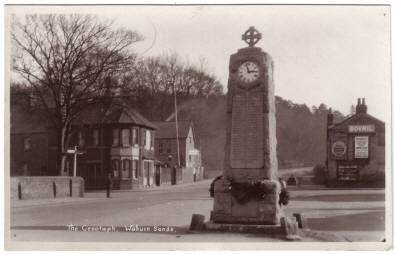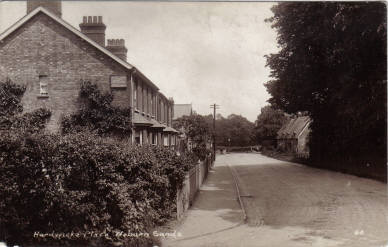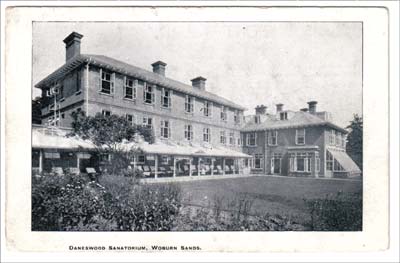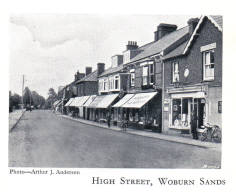“Woburn Sands – Where’s the sea?”
These are the memories of Eric Smith, born locally in 1927.
“I was born in 1927 at Woburn, and my formative years were spent at Woburn Sands where my Father was an Undertaker and Builder, this combination of occupations was not unusual in small rural areas prior to 1939. My Mother was a one time Secretary of the local Mothers Union and member of the W.I. and also took an interest in local affairs. Educated at The Bedford Modern School, I went on to Loughborough College and trained as a teacher. I was called up, and assigned to the Royal Army Education Corps and posted to Italy where I served until demobalised. Back in ‘civvy street’, I was initially employed by the Marston Valley Brick Co. Ltd., as Italian Liaison Officer, an appointment that allowed me to study facets of Fletton brick manufacture. With the take over of M.V.B.C by The London Brick Company, I was placed on the staff of the Research & Development section at Stewartby, where as a Ceramic technologist, I managed the Quality Control Department. Long retired, I now live in Haywards Heath.”
Woburn Sands, on the boarders of Bedford and Buckinghamshire, has as with all once small communities, radically changed since the nineteen thirties – the time of my growing up. It was one of many small localities dotted around the area whose inhabitants rarely travelled further than the confines of their immediate surroundings, this in spite of the fact that the Oxford to Cambridge railway ran through it and there was a regular bus service linking through from Aylesbury to Bedford. It would have appeared that everyone knew everyone else and to a large extent everyone else’s business.
The village is forty-eight miles north of London – built on the northern slope of a low ridge of “Green Sand” that runs more or less West to East; towards the railway station at a lower level, this sandy soil gives way to clay. A major road runs North – South which before the construction of the M1 motorway carried a high proportion of goods traffic going north via Northampton. Another road East – West links through from Aylesbury to Bedford.
A memorial (a grey stone column surmounted by a cross under which was a clock) recording the names to the fallen of the First World War was in the centre of the main square, to one side was a horse trough flanked by a public telephone Box; while a couple of hundred yards to the south in front of the main entrance of the school was a heavy wooden snow plough which was fashioned to be horse-drawn. Steam lorries of the Blue Circle Cement Company would occasionally be seen replenishing the water of their boilers at the trough. Further across the square at a discreet distance conveniently close to the principle public house was a urinal.
For its’ size, the village was well endowed with four places of worship, an Anglican “St Michael’s”, a Roman Catholic and a Methodist Church, and the “Friends Meeting House” for the small number of Quakers in the area. The Pettit Memorial Hall that allowed for catering and had a stage, as did the Methodist Church Hall and the Social Club. The Club provided recreational needs of its members with a small hall cum theater complete with a stage, full curtains and lighting, a billiard room. a bar, grass tennis courts, a bowling green and one for croquet; further hard tennis courts were to be found next to the nurseries belonging to the White family and one at the bottom of Hardwick Road.

There were five public houses, The Swan with a small bowling green. The Fir Tree, The Royal Oak, The Weathercock and the Railway Hotel, backed up by an off licence at the corner of the High Street and Russell Street. There were three bakeries, two of which with cake shops attached, and a further baker who made deliveries from Aspley Guise – an adjoining village. Three milk farmers, Harris, Jackson and Whitmee vied for custom delivering door to door; it is interesting to note that up to about 1938 when a small bottling plant was installed in one of the dairies, delivery was made house to house from a heavy gauge two gallon milk bucket, the requested quantity of milk then ladled out with a “Gill” measure.
Six grocers were to be found centered mainly round the High Street, only three of which stocked more than a single variety of product, the other three being smaller attracted only families in the houses nearby, two butchers and a fishmonger, together with two greengrocers completed the list of outlets that served the gastronomic needs of the community. In the immediate vicinity of the school, three sweet shops were to be found, all three were owned and managed by spinsters, Miss Colman owned the larger, the Emmerton Sisters the corner shop with the other across from the school entrance; a further three, one selling newspapers, were along the High Street. Up until her death Miss Collins owned and ran a small shop at No.4 The Leys Terrace.

There were other enterprising persons offering their services, Mr Kilpin with his horse and cart selling fresh vegetables, Mr Dicky Linton the “Rag and Bone Man”, “Buffalo Bill”, my Mother’s name for a somewhat disheveled small man who offered a host of household cleansing agents somewhat cheaper than shop prices. A vendor of flavoured carbonated beverages known as “Corona” did the rounds of the village once a week. The “Fish and Chip” van calling twice a week in the late afternoon or early evening, while in the warmer summer weekends the “Walls” ice cream man with his “box tricycle” would go slowly round the village ringing a bell to attract customers. Mention must be made of the village beggar, Harry Hatton by name who traded on a physical disability to wring a few coppers from anyone likely to have any spare small change. It was he who one Christmas time was given a cheque by my Father for the sum of one pound, it later transpired that he had attempted to change the figure one to five pounds, unfortunately being only semi-literate, he had not altered the written word “One”.
Although there was a Gas Works adjacent to the railway station, little if any gas was used for general heating although gas was used for house lighting prior to the introduction of mains electricity, coal and/or wood provided the main source of heating, therefore a chimney sweep was of necessity to be found, kept fully occupied in the warmer months of the year. There were still a few houses that lacked mains electricity, here paraffin was used for lighting and cooking, the replenishment of this commodity was furnished by one of two vendors who called on customers every week, one of which is well remembered by his call, “Any hoil today, Madam?” Once a month the “Insurance Man” was to be seen doing his rounds collecting the penny or occasionally six pence from families who wished to save for a pension.
Along the High Street were two banks, Barclays and Westminster, a Jeweller, a household furnishing shop, a Post Office, a chemist, two hairdressing salons (ladies and gents), a dress shop, a drapery, a shoe shop (Miss Amey), book and stationery, (W. H. Smith & Son) an electrical retailer, a wool shop (Miss Dovey), a hardware store (Mr Popple) and two shops offering an assortment of household requirements, there was also a bespoke tailor, a photo studio, a dentist and a doctor’s surgery in Station Road – a continuation of the High Street. Being divided by two counties, the village and its environs were patrolled by three Policemen, one each responsible for the Buckinghamshire and Bedfordshire areas while the third paid for by the Duke of Bedford, was responsible for the Heath and woodland territory. This woodland area better known as The Heath was reforested in the 1920s as the vast majority of mature trees were felled by a company of Canadian troops during the 1914-18 War and shipped to France. Strangely there was no permanent Fire Station or regular Firemen prior to 1940.
Almost hidden among the woodlands at the top of Heath Road were two convalescent Homes, Daneswood and Homewood where patients were sent from the London area to recover after hospitalisation. It was from here where many a Londoner allowed out into the village was heard to ask “Where’s the sea?“, as the very name Woburn Sands conjured up the idea of salt air and sandy beaches.
Composed of Infants, Junior and Senior sections, the School firmly controlled by Mr John Codd the Headmaster – catered not only for children of Woburn Sands but also took pupils where necessary from Wavendon, Woburn, Aspley Guise and the then newly founded village of Brogborough.

A District Nurse (Miss Faulkner) assisted the Doctor with infirm or bedridden patients, a School Attendance Officer (Mr Norton) was on hand should the School Headmaster require his assistance. The Parish Council and the Parochial Church Council together with the Committees of the Women’s Institute and Mothers Union organised and assisted with the wellbeing of the community as a whole. To round off the services there were two Undertakers.
There were three garages; Rice’s, Pikesley’s and Blanchard, each organised and run by competent owners able and willing to take on any work required of the customer and each offering a different brand of petrol from the other: Regent, Esso, Shell or BP.
As well as the Gas Works on the north side of the railway station, two small Brick Works “Eastwoods” producing machine-made bricks, fired in a semi-continuous multi-chambered kiln having a tall chimney, the other “Dudley’s” firing hand-made bricks in what was possibly a “Clamp” type kiln. To the rear of the Station was the Franklins Coal Stock Yard which in turn backed onto the Station Hotel and then Hargreaves lumber yard and saw mill.
The nearest Cinema was to be found at Fenny Stratford, “The County” as it was later known, before being demolished after the War; there was another in Bletchley “The Studio”, constructed in the mid 1930’s both reached using an ancient single-decker bus run by Mr Leigh-Lancaster which left the village in time for the beginning of the evening show and returning ten or so minutes at the finish of the last programme. The cost of a return ticket was six pence, during the 1939-45 war this was the only means of reaching Woburn Sands from Bletchley Railway Station after the last train passing Woburn Sands had left. Many a local Service man was to use it to get home for leave.
Woburn, two and a half miles south, had a lot in common with Woburn Sands, was and remains however even today much smaller. It the seat of the Dukes of Bedford, and was licensed for a market place held on the cobbled Town Square fronting the Magistrate’s Court House. Almshouses dating from the late 18th century and a Fire Station built after a fire destroyed much of the old wooden housing are to be found at the end of the High Street.

Apart from the extensive park and woodlands, Woburn boasts a late 19th century church bounded to the south by a Ha-Ha wall fronting onto the roadway. The park with its paths and hand dug lakes was open to residents of the town; however a public gated road ran through it. The park is of interest since it is completely surrounded by a six-foot six high brick wall, this allows a herd of a unique species of deer to roam freely. One of the former Dukes was an amateur botanist and arranged for the planting of many and various rare trees in and area to the northeast of the park, he also planted many rhododendron bushes which, when in flower, are a sight well worth a visit.
Today Woburn Sands has changed considerably, gone is the School in Woburn Road, the horse trough, the urinal, the War Memorial has been moved to a site on what was once part of the Vicarage gardens, shops have changed hands others closed down, all the thatched cottages in Hardwick Place and the Leys long gone, the railway station downgraded, the last remaining dirt road paved, new houses built and modern street lighting installed. To cap it all Woburn Sands can boast a Town Mayor and Council.
If you have recollections of Woburn Sands before 1950, or perhaps know a relative who does, why not jot down some of those memories, or record them onto tape, before they are lost forever. That era will soon pass out of living memory. Or you could discuss the people and places detailed above with elderly relatives, and see if they can add any information. I would be pleased to transcribe any tapes you make and add memories to those here.
Webpage last updated Nov. 2018
